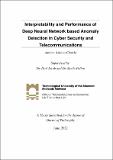| dc.contributor.advisor | Jacob, Paul | |
| dc.contributor.advisor | Fallon, Sheila | |
| dc.contributor.author | Chawla, Ashima | |
| dc.date.accessioned | 2022-12-20T12:00:22Z | |
| dc.date.available | 2022-12-20T12:00:22Z | |
| dc.date.copyright | 2022 | |
| dc.date.issued | 2022-06 | |
| dc.identifier.citation | Chawla, A. (2022). Interpretability and performance of deep neural network based anomaly detection in cyber security and telecommunications. Thesis (Doctor of Philosophy - PhD). Technological University of the Shannon: Midlands Midwest. | en_US |
| dc.identifier.uri | https://research.thea.ie/handle/20.500.12065/4346 | |
| dc.description.abstract | The rapid development of technology and proliferation of data have driven businesses to
pursue anomaly detection research. The application of artificial neural networks (ANNs) in
anomaly detection achieves the state-of-the-art, but the end user cannot easily interpret
their output. Therefore, to leverage ANNs in the field of Anomaly Detection, it is important
to interpret the neural network models. This thesis addresses the question of whether it
is possible to design and develop high performance and interpretable anomaly detection
solutions based on artificial neural networks.
Anomaly detection is an important technique in Cyber Security as, compared to signature
based methods, an anomaly detection based approach is capable of detecting previously
unseen attacks. One approach to develop a Host Based Intrusion Detection System for Cyber
Security is to examine sequences of traces of operating system calls. Two approaches to
anomaly detection for sequential data are a prediction based approach and a reconstruction
error based approach. A prediction based approach predicts the next element in a sequence
based on the previously observed sequence. The work incorporates stacked Convolutional
Neural Network (CNNs) with Gated Recurrent Units (GRUs) to analyse the operation system
call sequences with an order of magnitude smaller training times. The reconstruction error
based approach leverage bidirectional autoencoders to detect the anomalous system call se quences. This approach achieved better Area Under the Curve (AUC) when compared to the
predictive approach. This approach to anomaly detection forms the basis for an interpretability
framework.
Anomaly Detection is also an important technique in telecommunications monitoring. The
Cluster Characterized Autoencoder (CCA) Framework was designed, implemented, and evaluated to identify candidate anomalies and interpret the model predictions. This framework addresses the neural network interpretability to support network engineers to perform troubleshooting and aid in root cause analysis. | en_US |
| dc.format | PDF | en_US |
| dc.language.iso | eng | en_US |
| dc.publisher | Technological University of the Shannon: Midlands Midwest | en_US |
| dc.rights | Attribution-Non-Commercial-Share-Alike-3.0 United States | * |
| dc.rights.uri | http://creativecommons.org/licenses/by-nc-sa/3.0/us/ | * |
| dc.subject | Anomaly detection | en_US |
| dc.subject | Interpretation | en_US |
| dc.subject | System call traces | en_US |
| dc.title | Interpretability and performance of deep neural network based anomaly detection in cyber security and telecommunications | en_US |
| dc.type | info:eu-repo/semantics/doctoralThesis | en_US |
| dc.contributor.affiliation | Technological University of the Shannon: Midlands Midwest | en_US |
| dc.description.peerreview | yes | en_US |
| dc.identifier.orcid | https://orcid.org/0000-0001-5933-3107 | en_US |
| dc.rights.accessrights | info:eu-repo/semantics/openAccess | en_US |
| dc.subject.department | Department of Computer & Software Engineering: TUS Midlands | en_US |


